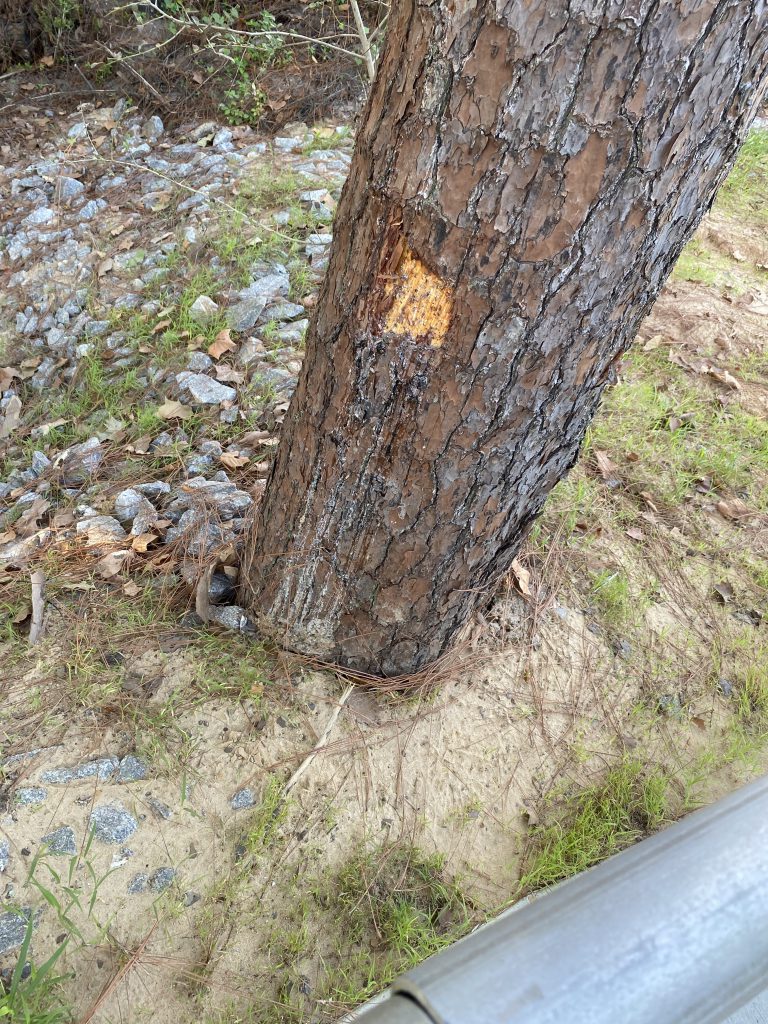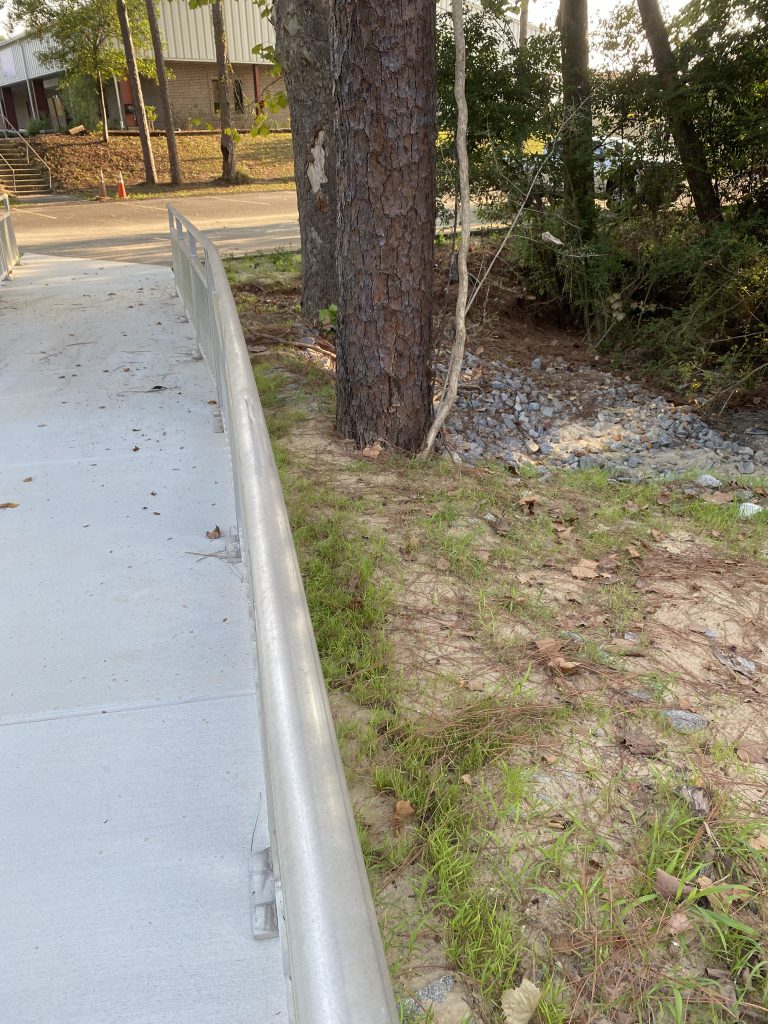It has been a hard summer climate wise and as we go into fall it is nice to start getting some relief from the heat. As the heat tones down, we are still facing a drought, which is not as severe as areas to our west but is still significant across much of the Panhandle. In our tree cover, the stress from the harsh summer this year is starting to show. You can see it in trees around the area, and it particularly seems to affect certain trees and conditions more than others. Where you are starting to see it most is in our ever-present pines, which make up the majority of our forest and tree cover in our region. If you keep a look out you may notice some pines in the areas with yellowing or brown needles or that are losing their needles. Those are clear signs of a possible bark beetle attack, which is a common issue when pines are stressed or damaged. Trees planted in the last year that are not yet fully established often show stress in a hot dry summer like this year. Even older and well-established trees in areas are showing some signs of stress from the hot dry conditions we have had this summer. Some trees are less adapted to dryer areas and when planted off site can experience more stress in dry conditions. If you look around across the Panhandle right now you can see clear signs of stress in some trees. It becomes more evident in late summer and early fall as the accumulated stressors of summer push trees into physiological conditions that cause stress responses. The big question is what to do if you notice a landscape tree that is exhibiting signs of stress, particularly drought stress.

For pines the issue is likely to be bark beetles, of which there are several types. All pine bark beetles are native to our area and the degree of damage they do varies by species and conditions. The issue with stressed trees is that most bark beetles attack those trees. When a hot dry summer occurs bark beetle activity increases as the stressed trees become less able to fend off attacks by these beetles. Unfortunately, when bark beetles attack a pine in an area the best answer is prompt removal and disposal of the infected tree material. To protect high value trees in an area where bark beetles are active there are some injection pesticides that can prevent infestation, but once a tree has been infested and begun to show symptoms little can be done to bring it back. When bark beetles attack a stressed pine, most are effectively finishing off a tree that may have died regardless. The key is to prevent them from spreading to other pines in the area or attracting them to a stressed tree in an area. With trees already stressed in our area the big prevention option is not to damage or stress any pines already on the landscape. Most pine bark beetles are attracted to trees by chemicals in pitch and resin given off by wounds or damage. Often the stress from new landscaping projects or construction around pines can cause several to succumb to bark beetles. Your best prevention is to keep equipment well away from the tree and avoid damaging or injuring the tree, especially scraping areas of bark off. Larger and older trees can be vulnerable, as well as overcrowded trees that are too dense or overtopped by others. As the cooler weather approaches bark beetle activity should decrease along with the risk of losing a pine to these pests.

For other trees there are additional precautions that can be taken to lessen the potential that a tree will succumb to drought and other stress. Newly planted trees or those established in the last several years are particularly at risk and should be watered regularly during this dry period. Until rains return, a good method of slowly applying water deeply to the root zone is best. Properly applied mulch can help keep the soil cooler and moist around a newly planted tree. Drip irrigation, soaker hoses, and similar methods are best, and a method that specifically applies water slowly to the tree’s root zone gives the best results. Watering your lawn does not supply sufficient water to landscape trees, especially in drought conditions. Lawn irrigation is designed to apply irrigation needed to the top portion of the soil that is available to the grass. Trees have completely different requirements and need different watering methods and amounts. If you don’t have dedicated irrigation available and you have a tree that needs water, you can use irrigation donuts or bags. These are often a good solution for a tree that needs watering temporarily. Once a tree is well established it usually can withstand even severe drought, but during the establishment phase paying attention to water needs is critical in a summer drought like we have had.
Large established trees are also not immune from the heat and dry conditions that have plagued the Panhandle this summer. Usually when conditions change these trees recover but may abort some branches or exhibit some leaf drop while stressed. Leaf drop is a phenomenon that can occur when deciduous trees are stressed. It is a method of conserving water needs by reducing the leaf demand. Usually, the tree will recover and leaf out again fine next year. A tree may abort some branches or have some branch tips die back to make it through a rough period. Trees that are overcrowded, overtopped, or have other issues are the most at risk from environmental stress. This is why good tree selection along with proper tree care and maintenance is essential. When a hot dry summer like we have had comes along well cared for and maintained trees do best. Trees that prefer more moisture like bald cypress, red maple, sycamore, and some oaks can be planted in dryer sites, but when a severe drought comes along they often don’t have the ability to handle the moisture stress that trees adapted to dryer sites can. This is why site selection is so important, it is when we have extreme conditions that off site plantings typically suffer the worst and those can be larger more established trees.
With the cool weather hopefully we will get a reprieve and some rain soon. Given that fall is one of our dryer periods it may be likely that drought conditions could persist until early winter. Good care and tree maintenance is essential to getting your trees through stressful periods like this summer. For younger trees watering and care is essential while they get established. For older established trees avoid doing any construction or other disturbing activities around them until conditions improve. If you have trees that are exhibiting signs of decline or pest attacks call your local extension office or Florida Forest Service County Forester office. With any luck, colder weather with winter rains will be here soon and trees in our area will recover over the dormant period.
- Pro-Tips for Dealing with Problem Oaks and Other Brush in the Home Landscape - November 21, 2024
- Elderberry: A Very Attractive and Useful Native Plant - June 20, 2024
- Pine Bark Beetles – With Warming Weather Comes More Activity - May 9, 2024
